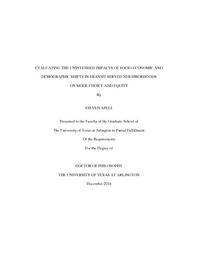
ATTENTION: The works hosted here are being migrated to a new repository that will consolidate resources, improve discoverability, and better show UTA's research impact on the global community. We will update authors as the migration progresses. Please see MavMatrix for more information.
Show simple item record
| dc.contributor.author | Apell, Steven | en_US |
| dc.date.accessioned | 2015-07-31T22:09:56Z | |
| dc.date.available | 2015-07-31T22:09:56Z | |
| dc.date.submitted | January 2014 | en_US |
| dc.identifier.other | DISS-12953 | en_US |
| dc.identifier.uri | http://hdl.handle.net/10106/24992 | |
| dc.description.abstract | The use of transit-oriented development (TOD) as a policy intervention is a popular strategy for metropolitan areas seeking to advance sustainable urban growth. At the same time, urban areas in America are experiencing rising energy prices and new geographies of employment, poverty, and wealth. Furthermore, the Millennial generation, and some Baby boomers are changing their residential preference from the suburbs to the central city. These modifications in the urban economy and residential preferences are likely to intensify competition for housing in the central city. Increased demand for housing generates high rents, which often results in the displacement of low-income, transit-dependent population. Consequently, the effectiveness of transit-oriented development is compromised as new affluent households increase vehicle use for home-based trips. Using 1990 and 2010 census data, this research investigated the unintended consequences of TOD policy on mode choice and equitable accessibility in block groups within one mile radius of rail stations in six metropolitan statistical areas. The research employed geographic information systems (GIS) and multivariate regression to analyze the relationship between socioeconomic and demographic change in transit-oriented development and associated effects on mode choice for work commute. The findings reveal that while driving declined between 1990 - 2010, transit use for work commute increased most metropolitan areas in the study. In addition, transit-oriented developments are associated with a high number of affluent households, college graduates, and White-collar employees, when compared with block groups with no transit-oriented development. However, the percentage of foreign-born residents have increased in transit-oriented development, while the percentage of Black and White population have declined. In addition, block groups within one mile of transit stations show nearly similar levels of transit use and driving when compared block groups within the half mile radius. These findings have significant implications on the long term effectiveness of TOD policy. | en_US |
| dc.description.sponsorship | Li, Jianling | en_US |
| dc.language.iso | en | en_US |
| dc.publisher | Urban & Public Affairs | en_US |
| dc.title | Evaluating The Unintended Impacts Of Socio-economic And Demographic Shifts In Transit Served Neighborhoods On Mode Choice And Equity | en_US |
| dc.type | Ph.D. | en_US |
| dc.contributor.committeeChair | Li, Jianling | en_US |
| dc.degree.department | Urban & Public Affairs | en_US |
| dc.degree.discipline | Urban & Public Affairs | en_US |
| dc.degree.grantor | University of Texas at Arlington | en_US |
| dc.degree.level | doctoral | en_US |
| dc.degree.name | Ph.D. | en_US |
Files in this item
- Name:
- APELL_uta_2502D_12953.pdf
- Size:
- 4.169Mb
- Format:
- PDF
This item appears in the following Collection(s)
Show simple item record


